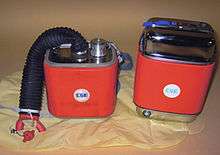Self-contained self-rescue device

A self-contained self-rescue device, SCSR, self-contained self-rescuer, or air pack is a portable oxygen source for providing breathable air when the surrounding atmosphere lacks oxygen or is contaminated with toxic gases, e.g. carbon monoxide. A SCSR is usually a closed-circuit breathing apparatus with a chemical oxygen generator or a compressed oxygen cylinder and a carbon dioxide absorber. SCSRs are most commonly used in some coal mines, are intended for one person, and usually supply at least one hour of oxygen. SCSRs are intended to facilitate escape from mines after a fire or explosion. They are also used by people working with machinery on the surface of a mine or pit, in case they become covered by such materials as coal or sand.[1] Usage of SCSRs for other purposes is discouraged.
Some SCSRs use potassium superoxide as a chemical oxygen source.
Faulty SCSRs were implicated in the Sago Mine disaster.
See also
References
- ↑ Stay Calm and Stay in the Cab! (Videotape). Mine Safety and Health Administration. 1999. Event occurs at 7m21s. DVD544-S. Retrieved 2013-08-04.
(In) each dozer on the job we have a self-rescuer that's located in a compartment directly above the operator's head.
| ||||||||||||||||||||||||||||||||||||||